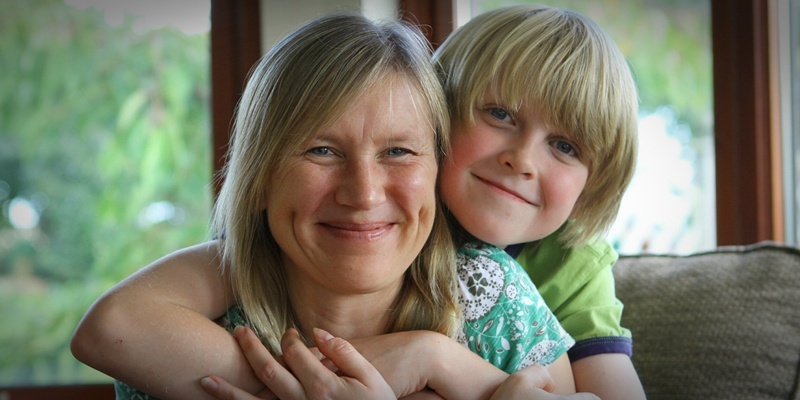The son of a Tayside cancer patient has turned Munro-bagger so others can receive the unconventional treatment that appears to have made his mother’s tumour shrink.
Last year Longforgan woman Michaela Thomason-Hughes (42), who was diagnosed with breast cancer in July 2009, could barely climb a flight of stairs.
Now that she is receiving mistletoe infusions alongside her conventional hormone therapy, she has been able to join son Luca (10) as he climbs for Mistletoe for Cancer UK.
Michaela first started receiving the treatment at Camphill Medical Practice in Aberdeen last October after undergoing a mastectomy, two types of chemotherapy and radiotherapy.
She received the first few doses of the seasonal plant extract intravenously and since then she has had maintenance therapy, injecting herself once a week and receiving a monthly IV infusion at the practice.
”Those first two weeks were really hard because by the time I got there I was really ill,” she said. ”I could hardly clean my own teeth.
”By the end of the month I was like a new woman. I went on to hormone therapy too. The mistletoe massively improves your quality of life. I was eating, I looked so much better.”
Michaela first discovered the mass in her right breast in July 2009, shortly after she and her family came back from living in Canada.
She said: ”Because of all the stress of moving, I hadn’t been doing examinations. When we got settled, I discovered a large mass in my right breast. At the time I thought it was a cyst. Between diagnosis and treatment it got bigger.”
When the tumour was finally diagnosed, doctors feared the cancer may have spread.
Michaela said: ”We were hoping for the best. Because the tumour was so big, they thought they would try to reduce it with chemo before surgery.”
By that November a scan revealed the cancer had got into her bloodstream and spread to her lungs. She was given another four rounds of additional chemo and then underwent a mastectomy in March before radiotherapy.
Doctors then delivered the crushing blow that they could not cure her but would monitor her and put her on tamoxifen.
A further scan revealed the lump in the lungs was getting bigger and she was given oral chemo which made her feel really sick.
”At the end of the summer I thought: Enough is enough,” she said. ”It didn’t make the tumour any smaller. It made me ill. I wanted a break.”
Michaela travelled to the Penny Brohn Cancer Centre in Bristol where she met one woman who told her about the mistletoe therapy that was giving her ”significant” tumour shrinkage.
She then set about persuading her consultant at Ninewells Hospital to let her try the treatment up in Aberdeen.
Michaela has now been on the mistletoe treatment for around a year, taking it alongside conventional hormone therapy.
She said: ”By March this year I’ve got significant tumour shrinkage. It’s not what they expect from hormone treatment.”
Doctors cannot promise that the therapy will eventually cause Michaela to be in remission but she said it has greatly improved her quality of life.
”They are very cautious with mistletoe,” she said. ”They can’t say it cures cancer. Some people go into remission.”
Michaela felt so much better she was able to take on a Munro with Luca recently.
She said: ”My son had never climbed one in his life before but in school they do projects and they wanted to help communities.
”My husband and various friends have been taking him. A few weeks ago I climbed a Munro when a year ago I could barely climb the stairs.”
Luca has already raised £480 for Mistletoe for Cancer UK, so other cancer sufferers can access the treatment.Centuries of medical useAlthough it is most commonly associated with Christmas kisses, mistletoe has been used for centuries to treat medical conditions such as epilepsy, hypertension, headaches and infertility.
Mistletoe infusions were championed by Rudolf Steiner and Ita Wegman in the 1920s and, since then, a number of research projects have been undertaken to investigate the effect of using mistletoe on tumours.
Mistletoe is classed as a biological response modifier, a substance that stimulates the body’s response to infection and disease.
Extracts of the plants have been shown in the lab to prevent the growth of new blood vessels needed for tumours to grow.
The therapy can be used safely alongside conventional treatment such as chemotherapy, radiotherapy and hormone therapy.
Mistletoe extracts are usually given by injection under the skin but can be given by mouth, intravenously, into the pleural cavity and into the tumour.
Luca is raising money for Mistletoe for Cancer UK, an initiative founded by patients and friends with the support of health professionals and Camphill Wellbeing Trust.
The charity aims to build awareness of mistletoe therapy and promote research.
